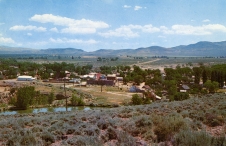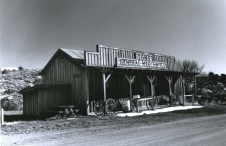Tonopah
The discovery of silver in south-central Nevada produced a major mining boom that revived the state's mining industry in the first decade of the twentieth century, and fueled a fierce economic recovery across the region. The Tonopah bonanza re-galvanized Nevada's status as a mining empire, organized a railway through its center, and may have preserved its status as a state in the union. For the next decade, Tonopah–together with Goldfield–served as a nucleus for state politics, and sparked the careers of some of the state's most powerful men. For the first time since the fall of the Comstock Lode, Nevada had reclaimed the nation's respect.
The boom started in 1900 when James L. Butler, a full-time rancher, part-time miner, and district attorney of Nye County, stumbled upon an ore sample while prospecting in Warren Averill Springs, south of his ranch in Belmont. Butler made a practice of mining in his spare time, and may have learned of the rich, black outcroppings from members of the local Shoshone tribe. It is generally accepted that Butler renamed the springs Tonopah after a Native American word meaning "greasewood water," but several other interpretations exist.
Many difficulties surrounded the initial discovery. First, Butler did not have the financial resources to pay for a professional assay of his samples. He enlisted the help of Tasker L. Oddie, an attorney, who forwarded them to Walter Gayhart, a schoolteacher. Both received stakes in the claim in exchange for their services. The partners had additional problems raising capital for development because of the pessimism that surrounded Nevada mining after the faded Comstock. Finally, the extraction of the ore was made difficult due to its remote location. There were no railroads nearby, and the water and timber necessary for a successful mining operation were scarce. Despite these difficulties, word of the discovery spread quickly, and a frenzied search for more deposits led to a major find in Goldfield, and smaller ones in Bullfrog, Manhattan, Rawhide, and Round Mountain.
Butler and his partners began exploiting the claims by granting verbal leases to miners. The leases included a 10,000-square-foot piece of land, and by 1901 over one hundred leases had been issued. This strategy lasted only a short time. On July 1, 1901, Butler and his partners sold the claims to a group of Philadelphia capitalists, who in turn formed the Tonopah Mining Company. A second company, the Tonopah-Belmont, also was established. By the end of 1901, Tonopah had grown to support thirty-two saloons, two dance halls, a newspaper, and two churches.
Freight routes were soon established to Sodaville, a small railroad station sixty-three miles to the west. The journey between the two towns was an arduous, two-day trek, and transporters quickly fell behind in moving ore and other necessary supplies. As a result, the Tonopah Railroad Company was formed, and a narrow-gauge railway was completed to the Carson and Colorado Railroad in Sodaville on July 23, 1904. But even that did not adequately relieve the congested supply lines. Work to complete a standard-gauge railroad soon followed, and the new track for the Tonopah Railroad was completed in August 1905. During this year Tonopah replaced Belmont as the seat of Nye County.
With the exception of a depression that hit in 1907, Tonopah grew steadily between 1901 and 1910, and the census recorded a population of 3,900 people at the end of the decade. Throughout these years a modern town emerged, with permanent buildings, electricity, and a town government. Many mining companies were formed, and in April 1905 the Big Casino opened, featuring a restaurant, saloon, and dance hall. In November 1908, the Mizpah Hotel held its grand opening. It featured oak furnishings, hot and cold running water, and an electric elevator. The population of Tonopah between 1900 and 1910 fluctuated between 5,000 and 10,000.
Tonopah, along with Goldfield, cultivated two generations of Nevada leadership. Key Pittman, a U.S. Senator and resident of Tonopah, convinced the U.S. Congress to pass the Pittman Act in 1918, which buoyed the town's economy by guaranteeing silver producers a minimum price of one dollar per ounce. Patrick McCarran came to Tonopah from Reno in 1905, and quickly developed a reputation as a feisty and capable defense attorney. McCarran later served on the Nevada Supreme Court between 1913 and 1918, and was elected to the U.S. Senate in 1932 to become the state's first native-born senator. Another, George Wingfield, leveraged his wealth from Tonopah and Goldfield to become one of Nevada's most powerful men.
Mining in Tonopah underwent several highs and lows until the 1920s, when the Pittman Act expired and production began to steadily taper off. At its peak in 1918, the district produced 622,364 tons of ore worth $9,311,560, but had reached a new low in 1930 when it yielded only $162,841. By 1940, the town had fallen into a deep depression. Yet between 1901 and 1941, Tonopah produced a staggering gross yield of $147,564,015.
The economic health of Tonopah was temporarily boosted when the U.S. Army completed the Tonopah Army Air Force Base just outside of town in July 1942. Suddenly there were jobs available for anyone who needed work, and the town again bustled. The base closed in 1948, but by 1952, the Tonopah Test Range and the Nevada Test Site were established to the south for nuclear testing purposes.
Another brief revival occurred in the early 1980s, when Anaconda Copper Company announced it would build a $200 million mining operation just north of Tonopah. The town experienced an immediate boom following the announcement, but Anaconda pulled out of the operation in 1986.
Tonopah survives today. Both the Tonopah Historic Mining Park and the Central Nevada Museum showcase the town's rich history. In 2000, the population was 2,627, with tourism and mining as key industries. The Tonopah Test Range and the Nevada Test Site continue as important employers for town residents. Tonopah remains the seat of rapidly growing Nye County.




